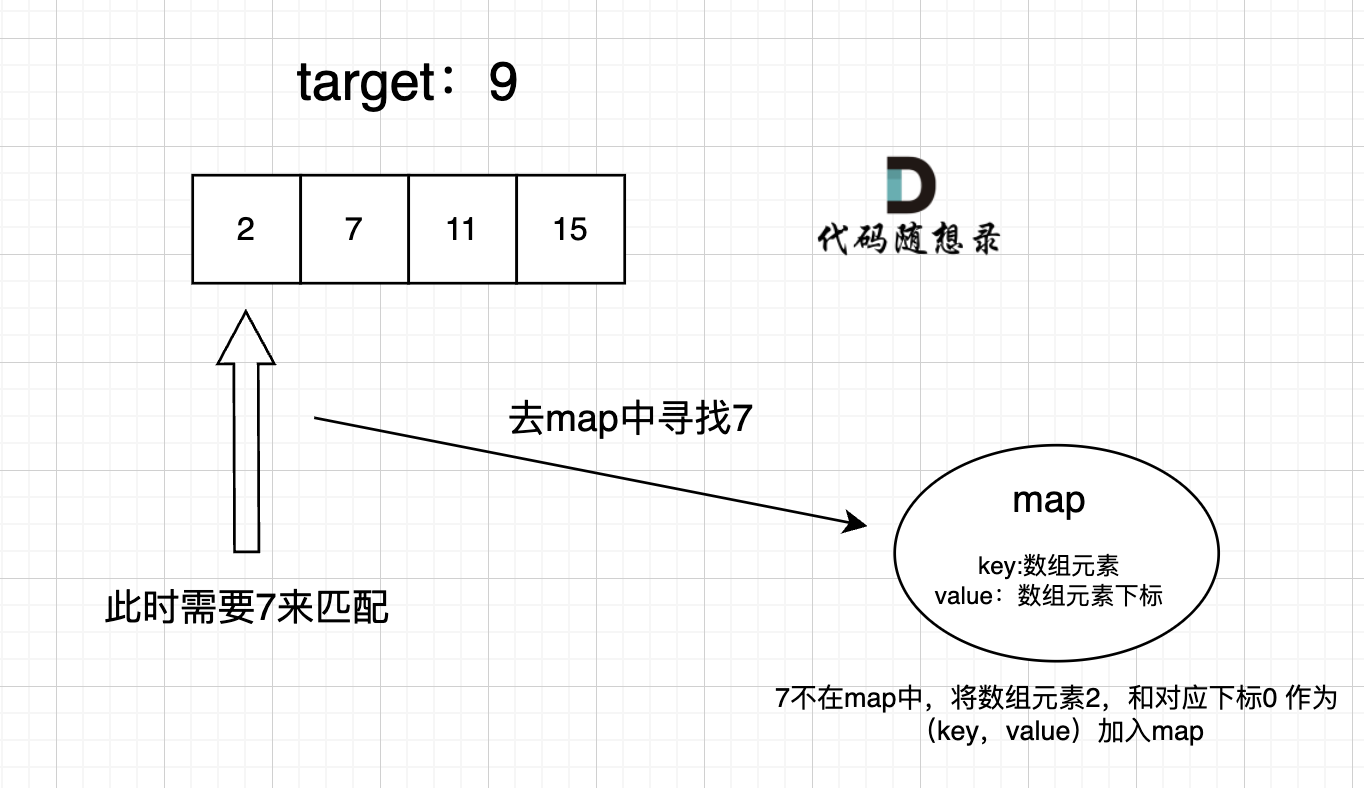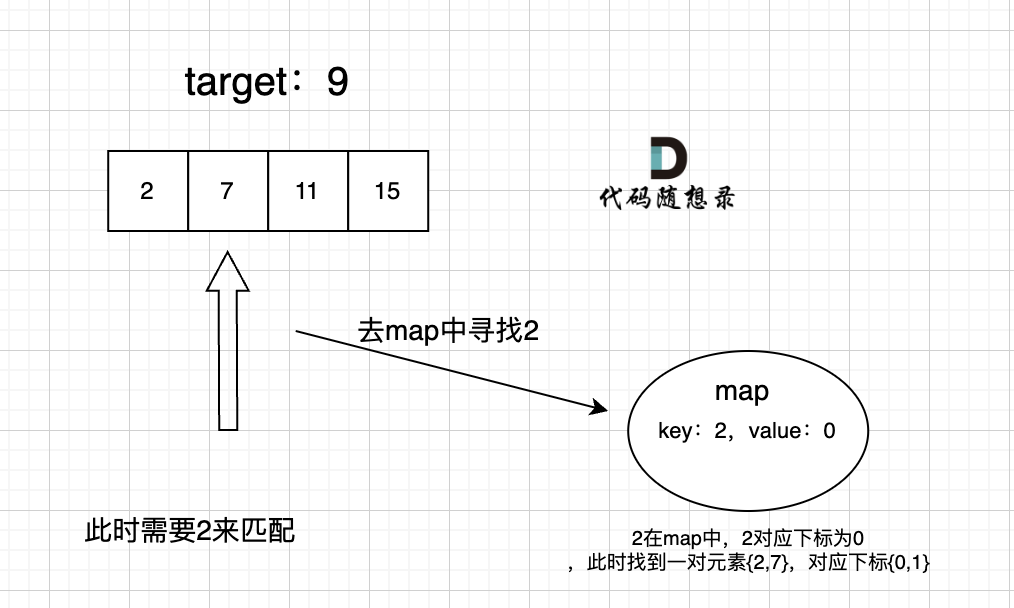- 做项目(多个C++、Java、Go、测开、前端项目) (opens new window)
- 刷算法(两个月高强度学算法) (opens new window)
- 背八股(40天挑战高频面试题) (opens new window)
# 1. 两数之和
给定一个整数数组 nums 和一个目标值 target,请你在该数组中找出和为目标值的那 两个 整数,并返回他们的数组下标。
你可以假设每种输入只会对应一个答案。但是,数组中同一个元素不能使用两遍。
示例:
给定 nums = [2, 7, 11, 15], target = 9
因为 nums[0] + nums[1] = 2 + 7 = 9
所以返回 [0, 1]
# 算法公开课
《代码随想录》算法视频公开课 (opens new window):梦开始的地方,Leetcode:1.两数之和 (opens new window),相信结合视频再看本篇题解,更有助于大家对本题的理解。
# 思路
很明显暴力的解法是两层for循环查找,时间复杂度是O(n^2)。
建议大家做这道题目之前,先做一下这两道
242. 有效的字母异位词 (opens new window) 这道题目是用数组作为哈希表来解决哈希问题,349. 两个数组的交集 (opens new window)这道题目是通过set作为哈希表来解决哈希问题。
首先我再强调一下 什么时候使用哈希法,当我们需要查询一个元素是否出现过,或者一个元素是否在集合里的时候,就要第一时间想到哈希法。
本题呢,我就需要一个集合来存放我们遍历过的元素,然后在遍历数组的时候去询问这个集合,某元素是否遍历过,也就是 是否出现在这个集合。
那么我们就应该想到使用哈希法了。
因为本题,我们不仅要知道元素有没有遍历过,还要知道这个元素对应的下标,需要使用 key value结构来存放,key来存元素,value来存下标,那么使用map正合适。
再来看一下使用数组和set来做哈希法的局限。
- 数组的大小是受限制的,而且如果元素很少,而哈希值太大会造成内存空间的浪费。
- set是一个集合,里面放的元素只能是一个key,而两数之和这道题目,不仅要判断y是否存在而且还要记录y的下标位置,因为要返回x 和 y的下标。所以set 也不能用。
此时就要选择另一种数据结构:map ,map是一种key value的存储结构,可以用key保存数值,用value再保存数值所在的下标。
C++中map,有三种类型:
| 映射 | 底层实现 | 是否有序 | 数值是否可以重复 | 能否更改数值 | 查询效率 | 增删效率 |
|---|---|---|---|---|---|---|
| std::map | 红黑树 | key有序 | key不可重复 | key不可修改 | O(log n) | O(log n) |
| std::multimap | 红黑树 | key有序 | key可重复 | key不可修改 | O(log n) | O(log n) |
| std::unordered_map | 哈希表 | key无序 | key不可重复 | key不可修改 | O(1) | O(1) |
std::unordered_map 底层实现为哈希表,std::map 和std::multimap 的底层实现是红黑树。
同理,std::map 和std::multimap 的key也是有序的(这个问题也经常作为面试题,考察对语言容器底层的理解)。 更多哈希表的理论知识请看关于哈希表,你该了解这些! (opens new window)。
这道题目中并不需要key有序,选择std::unordered_map 效率更高! 使用其他语言的录友注意了解一下自己所用语言的数据结构就行。
接下来需要明确两点:
- map用来做什么
- map中key和value分别表示什么
map目的用来存放我们访问过的元素,因为遍历数组的时候,需要记录我们之前遍历过哪些元素和对应的下标,这样才能找到与当前元素相匹配的(也就是相加等于target)
接下来是map中key和value分别表示什么。
这道题 我们需要 给出一个元素,判断这个元素是否出现过,如果出现过,返回这个元素的下标。
那么判断元素是否出现,这个元素就要作为key,所以数组中的元素作为key,有key对应的就是value,value用来存下标。
所以 map中的存储结构为 {key:数据元素,value:数组元素对应的下标}。
在遍历数组的时候,只需要向map去查询是否有和目前遍历元素匹配的数值,如果有,就找到的匹配对,如果没有,就把目前遍历的元素放进map中,因为map存放的就是我们访问过的元素。
过程如下:


C++代码:
class Solution {
public:
vector<int> twoSum(vector<int>& nums, int target) {
std::unordered_map <int,int> map;
for(int i = 0; i < nums.size(); i++) {
// 遍历当前元素,并在map中寻找是否有匹配的key
auto iter = map.find(target - nums[i]);
if(iter != map.end()) {
return {iter->second, i};
}
// 如果没找到匹配对,就把访问过的元素和下标加入到map中
map.insert(pair<int, int>(nums[i], i));
}
return {};
}
};
2
3
4
5
6
7
8
9
10
11
12
13
14
15
16
- 时间复杂度: O(n)
- 空间复杂度: O(n)
# 总结
本题其实有四个重点:
- 为什么会想到用哈希表
- 哈希表为什么用map
- 本题map是用来存什么的
- map中的key和value用来存什么的
把这四点想清楚了,本题才算是理解透彻了。
很多录友把这道题目 通过了,但都没想清楚map是用来做什么的,以至于对代码的理解其实是 一知半解的。
# 其他语言版本
# Java:
//使用哈希表
public int[] twoSum(int[] nums, int target) {
int[] res = new int[2];
if(nums == null || nums.length == 0){
return res;
}
Map<Integer, Integer> map = new HashMap<>();
for(int i = 0; i < nums.length; i++){
int temp = target - nums[i]; // 遍历当前元素,并在map中寻找是否有匹配的key
if(map.containsKey(temp)){
res[1] = i;
res[0] = map.get(temp);
break;
}
map.put(nums[i], i); // 如果没找到匹配对,就把访问过的元素和下标加入到map中
}
return res;
}
2
3
4
5
6
7
8
9
10
11
12
13
14
15
16
17
18
//使用哈希表方法2
public int[] twoSum(int[] nums, int target) {
Map<Integer, Integer> indexMap = new HashMap<>();
for(int i = 0; i < nums.length; i++){
int balance = target - nums[i]; // 记录当前的目标值的余数
if(indexMap.containsKey(balance)){ // 查找当前的map中是否有满足要求的值
return new int []{i, indexMap.get(balance)}; // 如果有,返回目标值
} else{
indexMap.put(nums[i], i); // 如果没有,把访问过的元素和下标加入map中
}
}
return null;
}
2
3
4
5
6
7
8
9
10
11
12
13
14
//使用双指针
public int[] twoSum(int[] nums, int target) {
int m=0,n=0,k,board=0;
int[] res=new int[2];
int[] tmp1=new int[nums.length];
//备份原本下标的nums数组
System.arraycopy(nums,0,tmp1,0,nums.length);
//将nums排序
Arrays.sort(nums);
//双指针
for(int i=0,j=nums.length-1;i<j;){
if(nums[i]+nums[j]<target)
i++;
else if(nums[i]+nums[j]>target)
j--;
else if(nums[i]+nums[j]==target){
m=i;
n=j;
break;
}
}
//找到nums[m]在tmp1数组中的下标
for(k=0;k<nums.length;k++){
if(tmp1[k]==nums[m]){
res[0]=k;
break;
}
}
//找到nums[n]在tmp1数组中的下标
for(int i=0;i<nums.length;i++){
if(tmp1[i]==nums[n]&&i!=k)
res[1]=i;
}
return res;
}
2
3
4
5
6
7
8
9
10
11
12
13
14
15
16
17
18
19
20
21
22
23
24
25
26
27
28
29
30
31
32
33
34
35
# Python:
(版本一) 使用字典
class Solution:
def twoSum(self, nums: List[int], target: int) -> List[int]:
records = dict()
for index, value in enumerate(nums):
if target - value in records: # 遍历当前元素,并在map中寻找是否有匹配的key
return [records[target- value], index]
records[value] = index # 如果没找到匹配对,就把访问过的元素和下标加入到map中
return []
2
3
4
5
6
7
8
9
(版本二)使用集合
class Solution:
def twoSum(self, nums: List[int], target: int) -> List[int]:
#创建一个集合来存储我们目前看到的数字
seen = set()
for i, num in enumerate(nums):
complement = target - num
if complement in seen:
return [nums.index(complement), i]
seen.add(num)
2
3
4
5
6
7
8
9
(版本三)使用双指针
class Solution:
def twoSum(self, nums: List[int], target: int) -> List[int]:
# 对输入列表进行排序
nums_sorted = sorted(nums)
# 使用双指针
left = 0
right = len(nums_sorted) - 1
while left < right:
current_sum = nums_sorted[left] + nums_sorted[right]
if current_sum == target:
# 如果和等于目标数,则返回两个数的下标
left_index = nums.index(nums_sorted[left])
right_index = nums.index(nums_sorted[right])
if left_index == right_index:
right_index = nums[left_index+1:].index(nums_sorted[right]) + left_index + 1
return [left_index, right_index]
elif current_sum < target:
# 如果总和小于目标,则将左侧指针向右移动
left += 1
else:
# 如果总和大于目标值,则将右指针向左移动
right -= 1
2
3
4
5
6
7
8
9
10
11
12
13
14
15
16
17
18
19
20
21
22
23
(版本四)暴力法
class Solution:
def twoSum(self, nums: List[int], target: int) -> List[int]:
for i in range(len(nums)):
for j in range(i+1, len(nums)):
if nums[i] + nums[j] == target:
return [i,j]
2
3
4
5
6
# Go:
// 暴力解法
func twoSum(nums []int, target int) []int {
for k1, _ := range nums {
for k2 := k1 + 1; k2 < len(nums); k2++ {
if target == nums[k1] + nums[k2] {
return []int{k1, k2}
}
}
}
return []int{}
}
2
3
4
5
6
7
8
9
10
11
func twoSum(nums []int, target int) []int {
m := make(map[int]int)
for i, num := range nums {
complement := target - num
if index, found := m[complement]; found {
return []int{index, i}
}
m[num] = i
}
return nil // 返回空数组 nil 代替空切片
}
2
3
4
5
6
7
8
9
10
11
# Rust:
use std::collections::HashMap;
impl Solution {
pub fn two_sum(nums: Vec<i32>, target: i32) -> Vec<i32> {
let mut map = HashMap::with_capacity(nums.len());
for i in 0..nums.len() {
if let Some(k) = map.get(&(target - nums[i])) {
if *k != i {
return vec![*k as i32, i as i32];
}
}
map.insert(nums[i], i);
}
panic!("not found")
}
}
2
3
4
5
6
7
8
9
10
11
12
13
14
15
16
17
use std::collections::HashMap;
impl Solution {
pub fn two_sum(nums: Vec<i32>, target: i32) -> Vec<i32> {
let mut hm: HashMap<i32, i32> = HashMap::new();
for i in 0..nums.len() {
let j = target - nums[i];
if hm.contains_key(&j) {
return vec![*hm.get(&j).unwrap(), i as i32]
} else {
hm.insert(nums[i], i as i32);
}
}
vec![-1, -1]
}
}
2
3
4
5
6
7
8
9
10
11
12
13
14
15
16
# JavaScript:
var twoSum = function (nums, target) {
let hash = {};
for (let i = 0; i < nums.length; i++) { // 遍历当前元素,并在map中寻找是否有匹配的key
if (hash[target - nums[i]] !== undefined) {
return [i, hash[target - nums[i]]];
}
hash[nums[i]] = i; // 如果没找到匹配对,就把访问过的元素和下标加入到map中
}
return [];
};
2
3
4
5
6
7
8
9
10
# TypeScript:
function twoSum(nums: number[], target: number): number[] {
let helperMap: Map<number, number> = new Map();
let index: number | undefined;
let resArr: number[] = [];
for (let i = 0, length = nums.length; i < length; i++) {
index = helperMap.get(target - nums[i]);
if (index !== undefined) {
resArr = [i, index];
break;
}
helperMap.set(nums[i], i);
}
return resArr;
};
2
3
4
5
6
7
8
9
10
11
12
13
14
# PhP:
function twoSum(array $nums, int $target): array
{
$map = [];
foreach($nums as $i => $num) {
if (isset($map[$target - $num])) {
return [
$i,
$map[$target - $num]
];
} else {
$map[$num] = $i;
}
}
return [];
}
2
3
4
5
6
7
8
9
10
11
12
13
14
15
# Swift:
func twoSum(_ nums: [Int], _ target: Int) -> [Int] {
// 值: 下标
var map = [Int: Int]()
for (i, e) in nums.enumerated() {
if let v = map[target - e] {
return [v, i]
} else {
map[e] = i
}
}
return []
}
2
3
4
5
6
7
8
9
10
11
12
# Scala:
object Solution {
// 导入包
import scala.collection.mutable
def twoSum(nums: Array[Int], target: Int): Array[Int] = {
// key存储值,value存储下标
val map = new mutable.HashMap[Int, Int]()
for (i <- nums.indices) {
val tmp = target - nums(i) // 计算差值
// 如果这个差值存在于map,则说明找到了结果
if (map.contains(tmp)) {
return Array(map.get(tmp).get, i)
}
// 如果不包含把当前值与其下标放到map
map.put(nums(i), i)
}
// 如果没有找到直接返回一个空的数组,return关键字可以省略
new Array[Int](2)
}
}
2
3
4
5
6
7
8
9
10
11
12
13
14
15
16
17
18
19
# C#:
public class Solution {
public int[] TwoSum(int[] nums, int target) {
Dictionary<int ,int> dic= new Dictionary<int,int>();
for(int i=0;i<nums.Length;i++){
int imp= target-nums[i];
if(dic.ContainsKey(imp)&&dic[imp]!=i){
return new int[]{i, dic[imp]};
}
if(!dic.ContainsKey(nums[i])){
dic.Add(nums[i],i);
}
}
return new int[]{0, 0};
}
}
2
3
4
5
6
7
8
9
10
11
12
13
14
15
# Dart:
import 'dart:collection';
List<int> twoSum(List<int> nums, int target) {
HashMap<int, int> hashMap = HashMap();
for (int i = 0; i < nums.length; i++) {
int rest = target - nums[i];
if (hashMap.containsKey(rest)) {
return [hashMap[rest]!, i];
}
hashMap.addEntries({nums[i]: i}.entries);
}
return [];
}
2
3
4
5
6
7
8
9
10
11
12
13
# C:
/**
* Note: The returned array must be malloced, assume caller calls free().
*/
// leetcode 支持 ut_hash 函式庫
typedef struct {
int key;
int value;
UT_hash_handle hh; // make this structure hashable
} map;
map* hashMap = NULL;
void hashMapAdd(int key, int value){
map* s;
// key already in the hash?
HASH_FIND_INT(hashMap, &key, s);
if(s == NULL){
s = (map*)malloc(sizeof(map));
s -> key = key;
HASH_ADD_INT(hashMap, key, s);
}
s -> value = value;
}
map* hashMapFind(int key){
map* s;
// *s: output pointer
HASH_FIND_INT(hashMap, &key, s);
return s;
}
void hashMapCleanup(){
map* cur, *tmp;
HASH_ITER(hh, hashMap, cur, tmp){
HASH_DEL(hashMap, cur);
free(cur);
}
}
void hashPrint(){
map* s;
for(s = hashMap; s != NULL; s=(map*)(s -> hh.next)){
printf("key %d, value %d\n", s -> key, s -> value);
}
}
int* twoSum(int* nums, int numsSize, int target, int* returnSize){
int i, *ans;
// hash find result
map* hashMapRes;
hashMap = NULL;
ans = malloc(sizeof(int) * 2);
for(i = 0; i < numsSize; i++){
// key 代表 nums[i] 的值,value 代表所在 index;
hashMapAdd(nums[i], i);
}
hashPrint();
for(i = 0; i < numsSize; i++){
hashMapRes = hashMapFind(target - nums[i]);
if(hashMapRes && hashMapRes -> value != i){
ans[0] = i;
ans[1] = hashMapRes -> value ;
*returnSize = 2;
return ans;
}
}
hashMapCleanup();
return NULL;
}
2
3
4
5
6
7
8
9
10
11
12
13
14
15
16
17
18
19
20
21
22
23
24
25
26
27
28
29
30
31
32
33
34
35
36
37
38
39
40
41
42
43
44
45
46
47
48
49
50
51
52
53
54
55
56
57
58
59
60
61
62
63
64
65
66
67
68
69
70
71
72
73
74
75
76
77
78
